You are viewing 1 of your 1 free articles
Game fundamentals
| Area | Two thirds of a pitch |
| Equipment | Balls, bibs, cones, 6 mannequins, 2 goals |
| No. of Players | 18 players + 2 goalkeepers |
| Session Time | Up to 30 minutes |
This game-based session is designed to focus on, and drill down on, some of the simple game fundamentals inside of our process. In a simple way, we can touch on each moment of the game with simple messages.
When we pass messages to the players while playing and competing, the quicker these messages can turn into actions, and with time and repetition into an automatic habit, it becomes what we are as a team. This is a go-to exercise for us to introduce, revise and train our most basic fundamentals of the game.
We would run this during a certain stage of pre-season in order to instil our key messages in all of the players. As we progress with a new group of players, these games become more competitive. During the season, when the schedule permits, we also like to do this work in clear weeks, sometimes as a means of ‘revision’, or maybe we might add some more specific detail to the work that is either relevant to the next opponent we are facing or for how we are developing the team.
“This is a go-to exercise for us to introduce, revise and train our most basic fundamentals of the game”
GAME FUNDAMENTALS PRACTICE
We set up a playing area of 60x48 yards (or between the penalty boxes with the pitch coned off 10 yards in from each touchline). We position a goal and a goalkeeper at each end and position six mannequins as shown.
We’re using 18 outfield players split into three teams of six. Two teams start in the central area in a 6v6 and they have unlimited touches, while the third team support the possession team from outside the playing area, as shown [1a]. The outside team are limited to two touches and they have two players at each end on either side of the goals and two players working up and down the wing with one on each side of the pitch.
The aim for the team in possession is to build from the back and attack centrally to score. The attacking team can use any of the six yellow support players on the outside of the pitch to provide them with a numerical advantage. When the ball is played to a support player on either side from the defending half and it is played back inside, then both side support players (the full backs) should advance up the wing into the opposition’s half, as shown [1b].
[1a]

2. The third team supports the possession team from the outside. The outside players are limited to two touches
[1b]
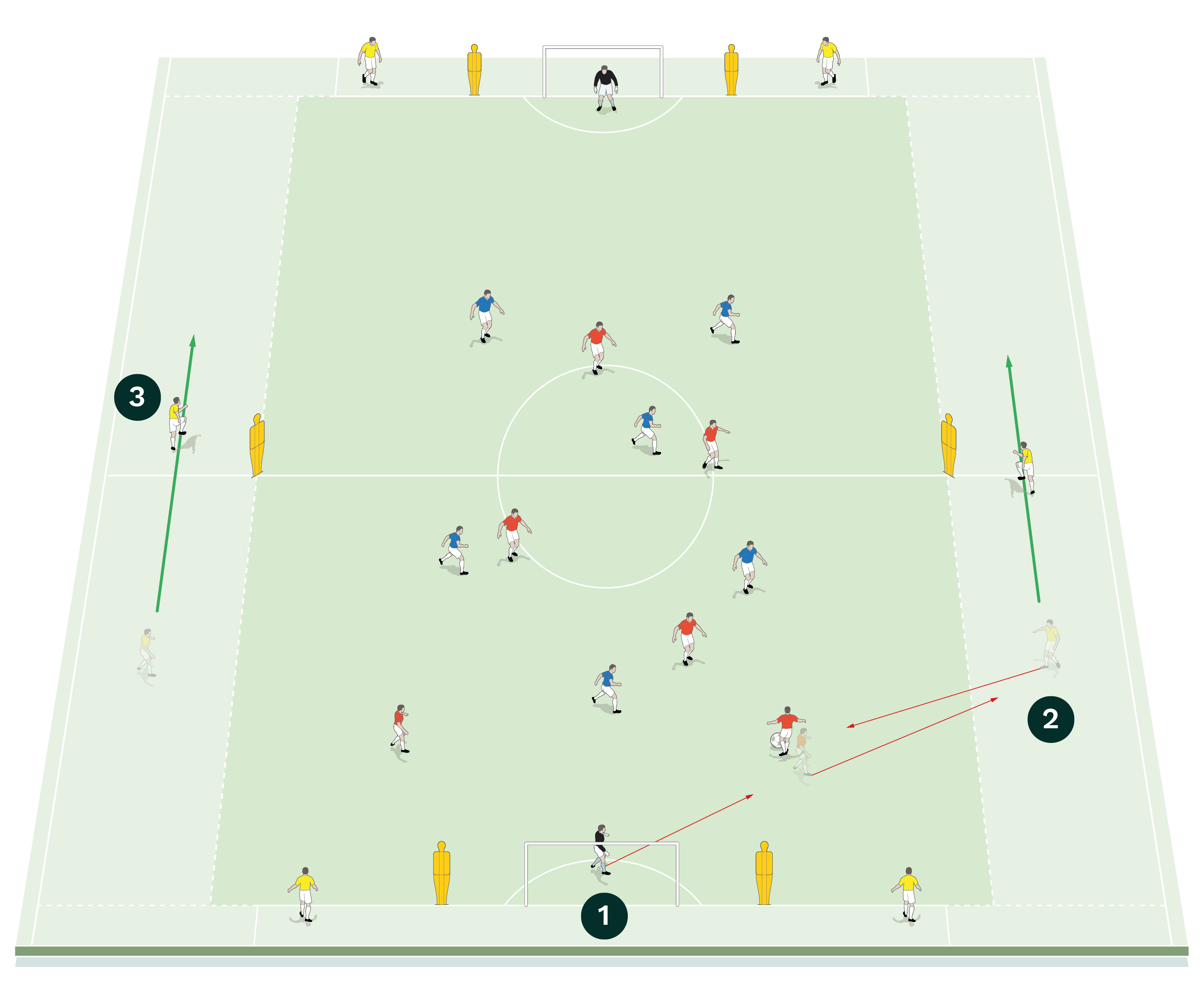
2. The red attacking team can use any of the players on the outside for support and to give them an overload
3. When the ball is played to a yellow support player from the defending half and is played back inside, then both side support players can advance into the attacking half
Once both yellow side support players have moved forwards into the attacking half, the aim for the team in possession is to find ways to attack centrally to score. Once the ball is in the attacking half, the team in possession now have four high support players that they can use to help them create goal-scoring opportunities, as shown [1c].
If it is not possible to find passes to attack centrally, then a midfield player can ‘open to the side’ in order to take up the original position of the yellow side support player. When a player from the team in possession moves to the outside of the pitch to receive, they are now limited to two touches to play the ball forwards down the side to a support player to progress the play, as shown [1d].
On receiving the ball, the player who has opened to the side has the option to play vertically down the side to a support player or back inside into the pitch to a team-mate, as shown [1e]. They can then re-join the game on the inside.
[1c]
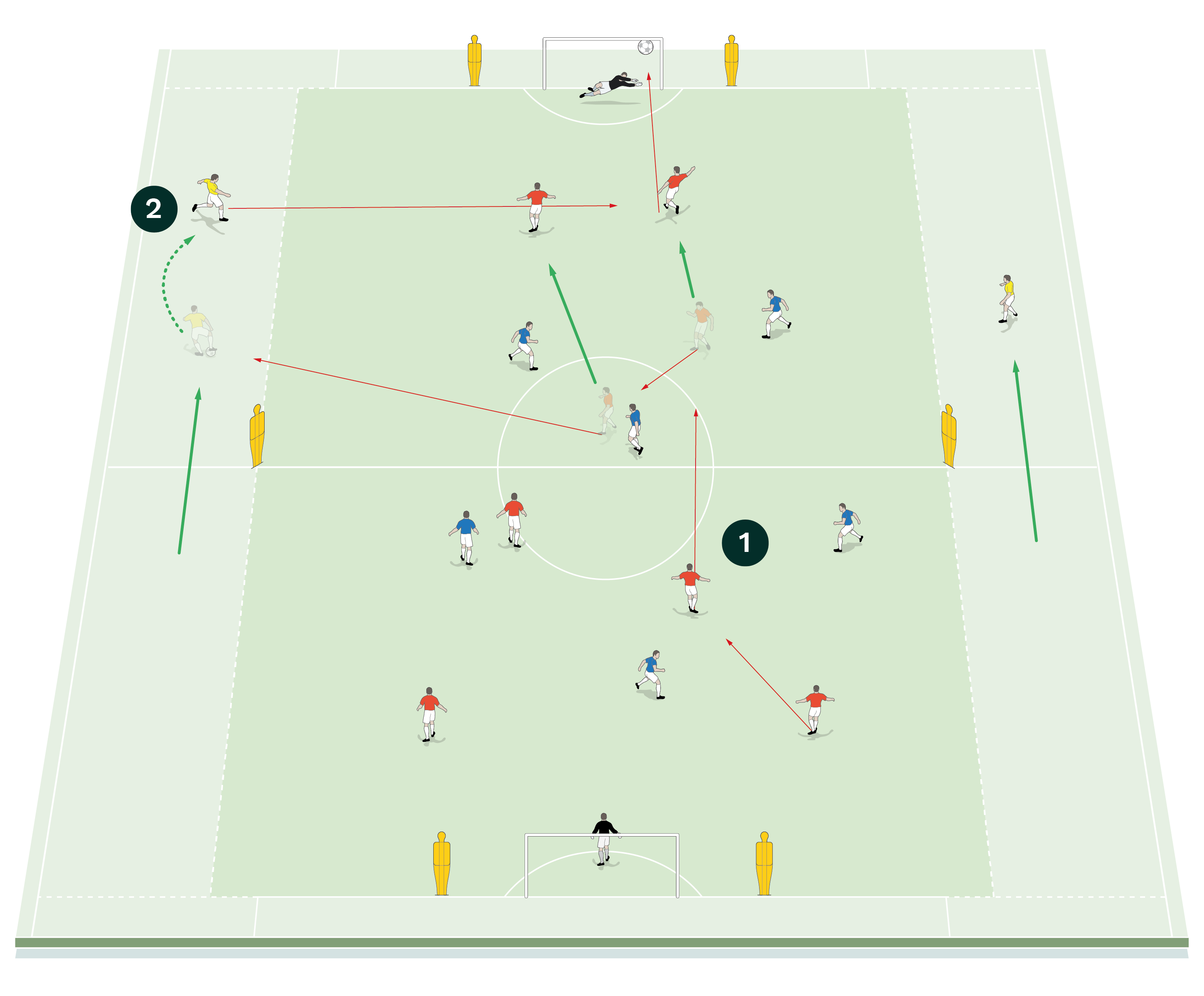
the red possession team must find ways to attack centrally
2. When the ball is in the attacking half, the reds can use the support of the four yellow outside players in that half to help them to create goal-scoring opportunities
[1d]
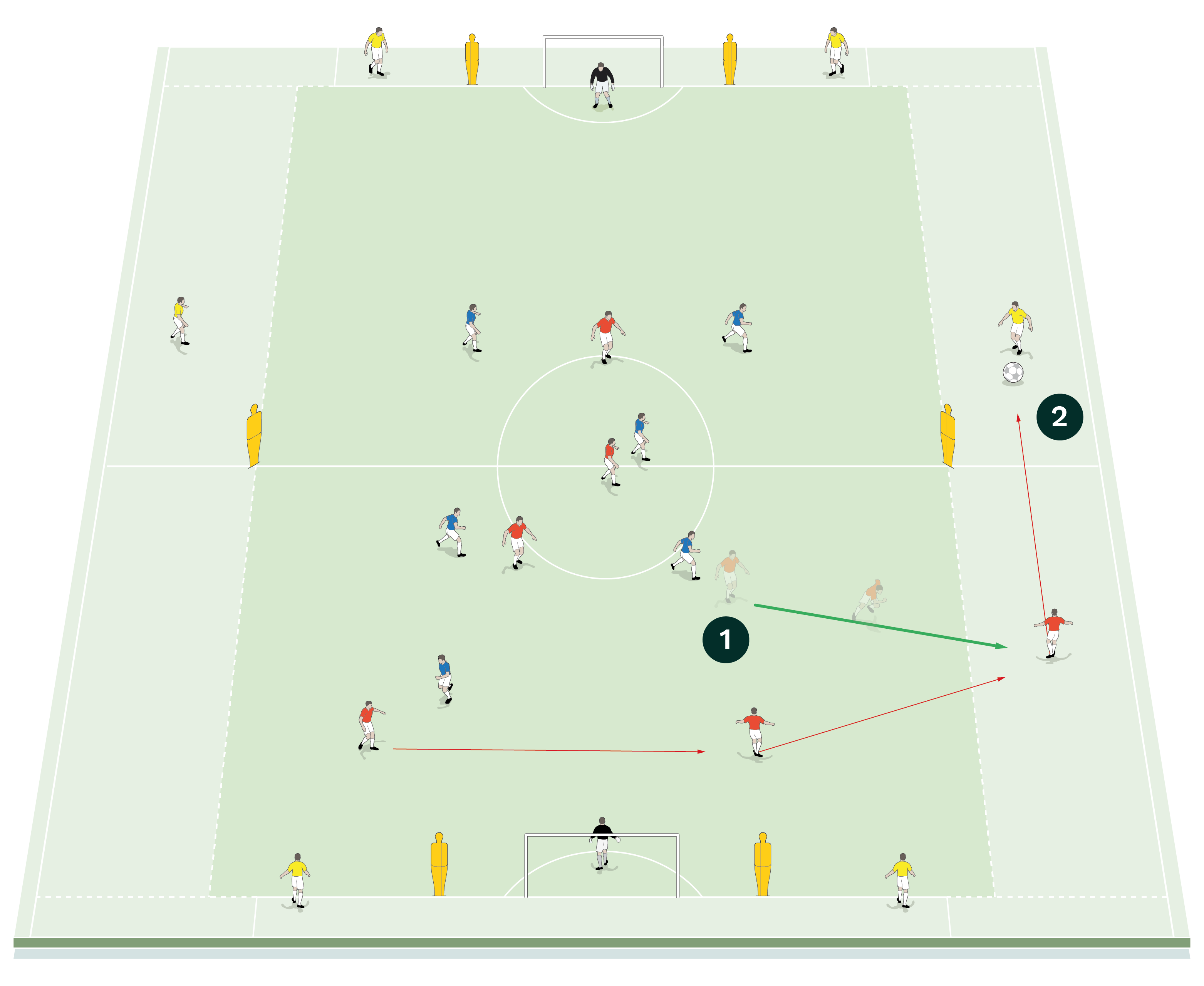
2. When a player from the team in possession moves to the outside to receive, they now have only two touches to play the ball forwards down the side to a yellow support player to progress the play
[1e]
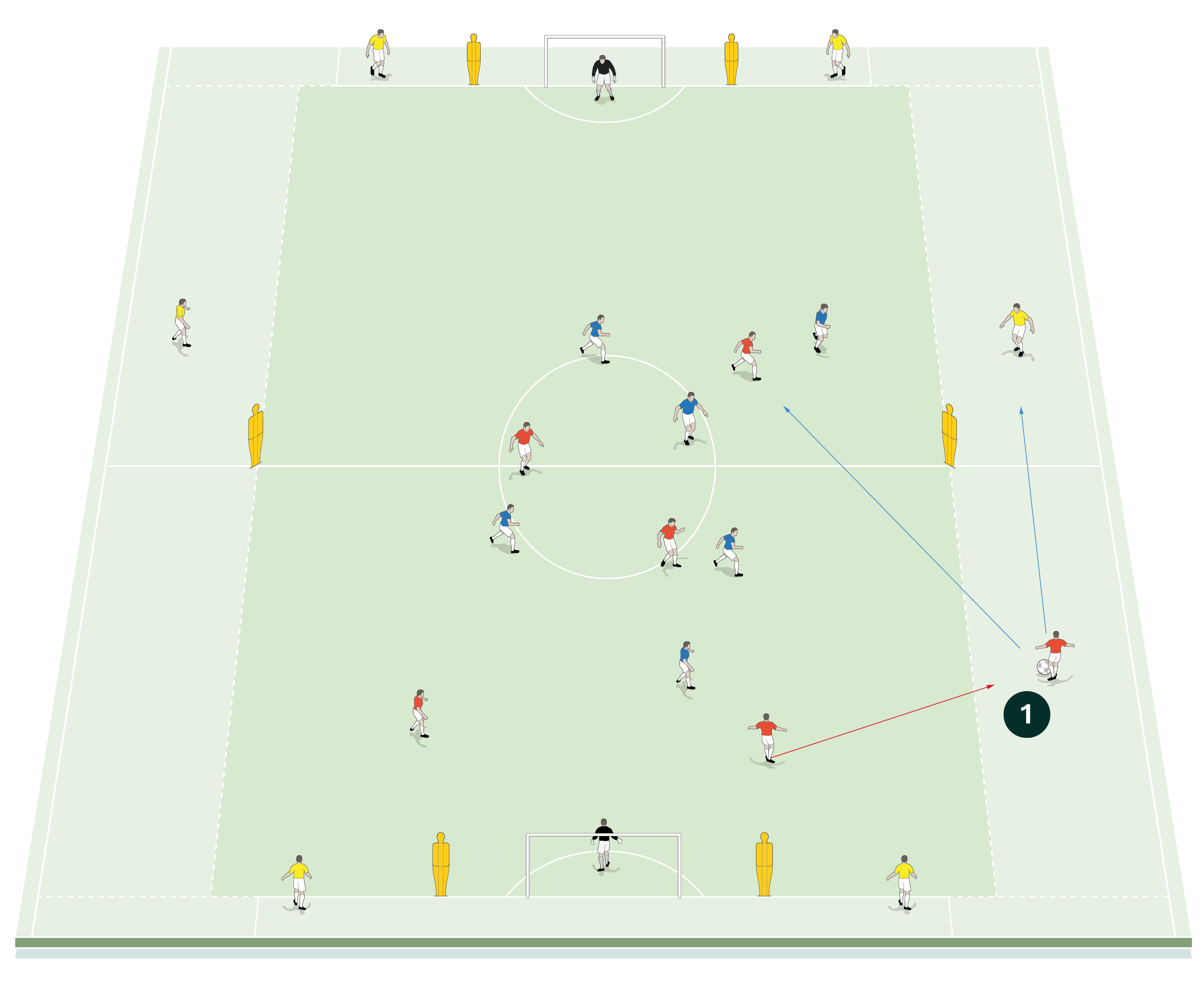
[1f]
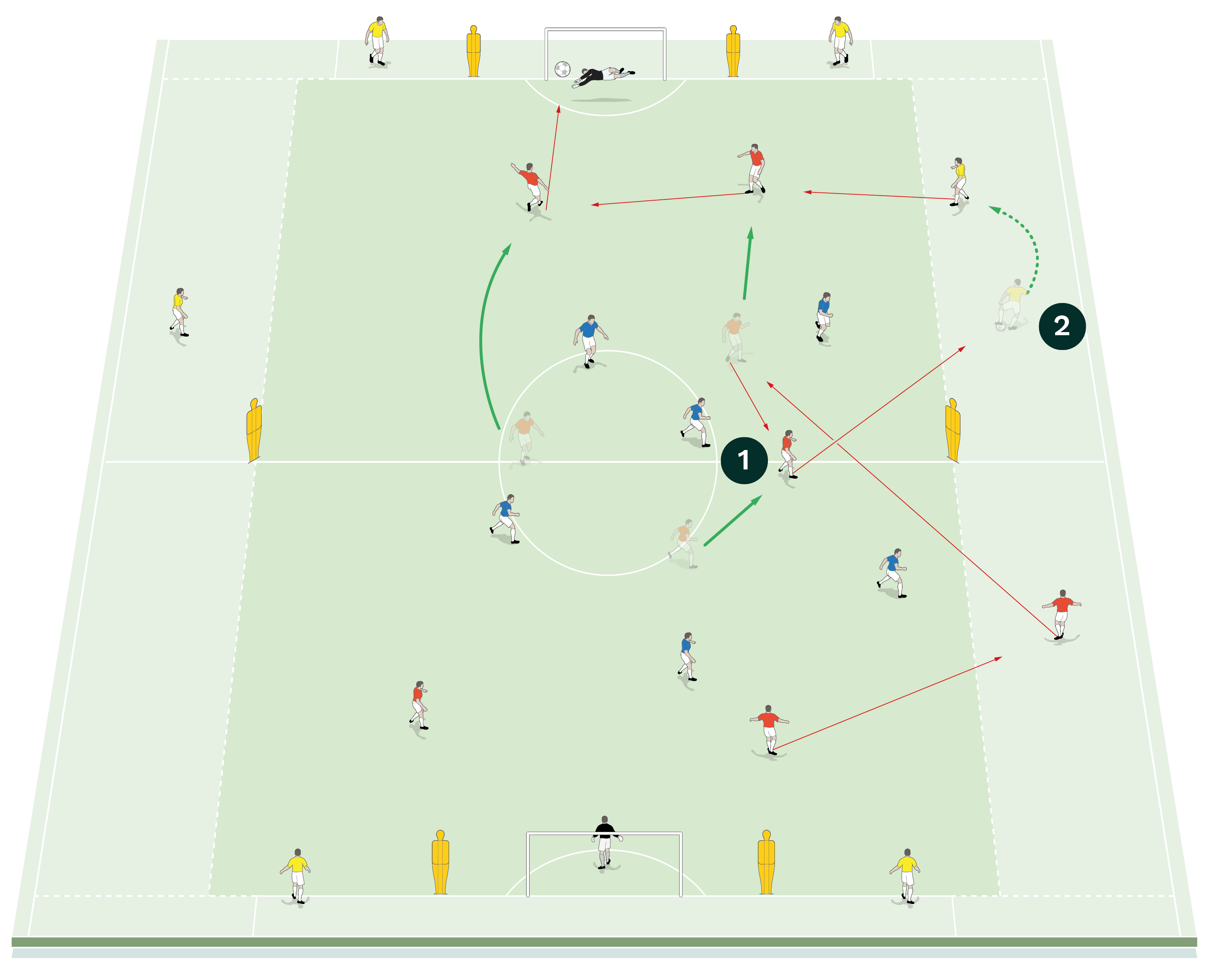
2. Here the supporting wide yellow receives the ball on the outside and dribbles before passing into the centre
[1g]

2. The aim for the blue defending team who have now won possession, is to find a side support player as quickly as possible
3. The blues have two options. They can secure possession and build an attack centrally or the side support player can play a vertical pass down the side for a blue forward player who has made a diagonal run to the outside to receive
“How one team can control the momentum of these short games depends on how well they make decisions in each moment of the play”
The team in possession should aim to produce combination play using players inside the pitch or the support players on the outside to create goal-scoring opportunities, as shown [1f].
When all the players are in the attacking half and there is a turnover of possession, the red team (who have lost possession of the ball) should press aggressively to try to win it back. The aim for the blue defending team who have now won possession of the ball is to find a pass to a side support player as quickly as possible. In reality, the blues have two options: to secure possession and build an attack themselves or for the side support player to play a vertical pass down the side for a forward player who has made a diagonal run to the outside to receive, as shown [1g].
When this vertical pass down the side is played, a counter-attack is initiated and must be completed. The forward who has moved to the outside has two touches maximum to play the ball back inside to a supporting team-mate – the attack then continues to a finish, as shown [1h].
The main thing about the session is that the structure and rules of the set-up allows the thinking of the players to become in tune and aligned with each other, so we will start to see ‘team decision-making’. And any work on the training ground that helps the team members think the same things, feel the same things and see the same things, is work that makes a team better.
We play three-minute games. Each of the teams plays each other once in each round of three games. Dependent on the physical load for the day, we play three rounds of games, meaning each team will play six games on the central pitch and three games on the outside as the support team.
[1h]
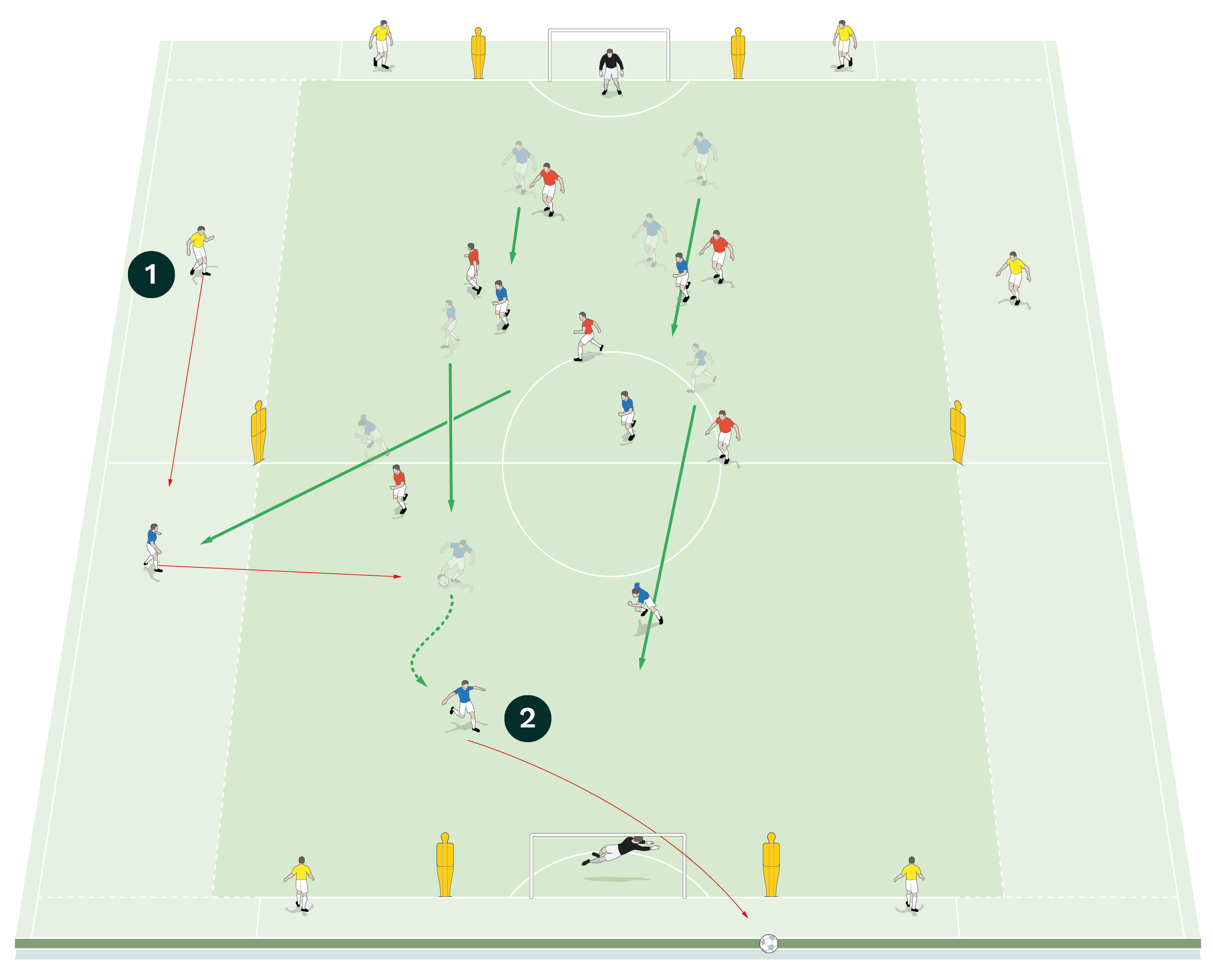
2. The blue forward who has moved to the outside has two touches to play the ball back inside to a supporting team- mate. The attack then continues to a finish
COACHING POINTS
How do I progress the session?
The players’ understanding of the game, its rules, the structure of it and the options it therefore gives them, informs their decision-making and this brings the work to life. The quality of the players and their intelligence is what progresses this session.
What are the key things to look for?
This becomes entirely about decision-making – individually and collectively. How one team can control the momentum of these short games depends on how well they make decisions in each moment of the play: how they read the situation, how they collaborate, and how they learn to think the same things at the same time.
How would I put this in a game situation?
The set-up of this activity allows us to have the game situation already in place, although it is a touch manipulated. What we expect is to see the benefit of this work transferred when we progress to two-team game-work, whether it be at 8v8 or 10v10.
Related Files
Editor's Picks
Deep runs in the final third
Using the goalkeeper in build-up play
Pressing principles
Intensive boxes drill with goals
Penetrating the final third
Creating and finishing
My philosophy
Pressing initiation
Compact team movement
Coaches' Testimonials

Alan Pardew

Arsène Wenger

Brendan Rodgers

Carlos Carvalhal

José Mourinho

Jürgen Klopp

Pep Guardiola

Roy Hodgson

Sir Alex Ferguson

Steven Gerrard
Coaches' Testimonials

Gerald Kearney, Downtown Las Vegas Soccer Club

Paul Butler, Florida, USA

Rick Shields, Springboro, USA

Tony Green, Pierrefonds Titans, Quebec, Canada
Join the world's leading coaches and managers and discover for yourself one of the best kept secrets in coaching. No other training tool on the planet is written or read by the calibre of names you’ll find in Elite Soccer.
In a recent survey 92% of subscribers said Elite Soccer makes them more confident, 89% said it makes them a more effective coach and 91% said it makes them more inspired.
Get Monthly Inspiration
All the latest techniques and approaches
Since 2010 Elite Soccer has given subscribers exclusive insight into the training ground practices of the world’s best coaches. Published in partnership with the League Managers Association we have unparalleled access to the leading lights in the English leagues, as well as a host of international managers.
Elite Soccer exclusively features sessions written by the coaches themselves. There are no observed sessions and no sessions “in the style of”, just first-hand advice delivered direct to you from the coach.









